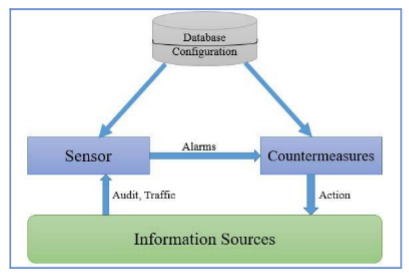A Robust Intrusion Detection Mechanism in Wireless Sensor Networks Against Well-Armed Attackers
Keywords:
intrusion detection, wireless sensor networks, attack detection, energy managementAbstract
Recent research has given sufficient attention to intrusion detection as one of the most significant techniques to guaranteeing wireless sensing network security. However, with the advent of electronic anti-reconnaissance equipment, the intruder may learn the precise locations of detecting nodes and then use proposed system data to plot a course that will take him or her past them undetected. Such a threat is characterized as an empowered invader who poses novel difficulties for existing intrusion detection techniques. When detection nodes are first deployed at random, coverage gaps may appear in certain places, making it impossible to achieve the intended detection impact. To combat these problems, we provide a concept for a sensing network in which cars work together to offer intrusion detection against armed attackers. Our solution incorporates a sleep-scheduling technique for stationary nodes and an algorithm for mobile sensing devices to pursue targets. To close the coverage gaps, mobile monitoring devices will follow the empowered intruder, meanwhile static nodes will adhere to a sleep-scheduling algorithm and be roused by neighboring detection nodes. To evaluate the efficacy of our concept in terms of intrusion detection, energy consumption, and the range over which sensor nodes may move, we conduct simulation experiments against established methods. Extensive simulations are also run to examine the sensitivity of the parameters. Our idea has been shown to be more efficient and available through theoretical research and simulation.
Downloads
References
Alippi, G. Anastasi, C. Galperti, F. Mancini, and M. Roveri, ‘‘Adaptive sampling for energy conservation in wireless sensor networks for snow monitoring applications,’’ in Proc. IEEE INTERNATONAL Conf. Mobile Adhoc Sensor Syst.,Oct.2007, pp.1-6.
Falcon, X. Li, and A. Nayak, ‘‘Carrier-based focused coverage formation in wireless sensor and robot networks,’’ IEEE Trans. Autom. Control, vol. 56, no. 10, pp. 2406–2417, Oct. 2011.
Heinzelman, A.Chandrakasan, and H. Balakrishnan,‘‘Energy-efficient Communication protocol for wireless microsensor networks,’’ in Proc. 33rd Annu. Hawaii Int. Conf. Syst. Sci., Aug. 2005, p. 10
Kim and J. Ben-Othman, ‘‘A collision-free surveillance system using smart UAVs in multi domain IoT,’’ IEEE Commun. Lett., vol. 22, no. 12, pp. 2587–2590, Dec. 2018.
Kumar, T. H. Lai, M. E. Posner, and P. Sinha, ‘‘Maximizing the lifetime of a barrier of wireless sensors,’’ IEEE Trans. Mobile Comput., vol. 9, no. 8, pp. 1161–1172, Aug. 2010.
Lambrou, ‘‘Optimized cooperative dynamic coverage in mixed sensor networks,’’ ACM Trans. Sensor Netw., vol. 11, no. 3, pp. 1–35, Feb. 2015.
Liu, W. Wei, H. Wang, Y. Zhang, Q. Zhang, and S. Li, ‘‘Intrusion detection based on parallel intelligent optimization feature extraction and distributed fuzzy clustering in WSNs,’’ IEEE Access, vol. 6, pp. 72201–72211, 2018.
Meguerdichian, F. Koushanfar, and G. Qu, ‘‘Exposure in wireless adhoc sensor networks,’’ in Proc. 7th Annu. Int. Conf. Mobile Comput. Netw., 2001, pp. 139–150.
Rajan, D. Antony Joseph, and E. R. Naganathan. "Long and Strong Security using Reputation and ECC for Cloud Assisted Wireless Sensor Networks." Scalable Computing: Practice and Experience 21.1 (2020): 85-92.
Rajan, D. Antony Joseph, and E. R. Naganathan. "Trust Based Anonymous Intrusion Detection for Cloud Assisted WSN-IOT." Global Transitions Proceedings (2022).
Rajan, D. Antony Joseph, and E. R. Naganathan. "Identity verification-based cryptography for detecting intrusion in wireless sensor networks." International Journal of Vehicle Information and Communication Systems 4.4 (2019): 375-387.
Sun, P. Wang, M. C. Vuran, M. A. Al-Rodhaan, A. M. Al-Dhelaan, and I. F. Akyildiz, ‘‘BorderSense: Border patrol through advanced wireless sensor networks,’’ Ad Hoc Netw., vol. 9, no. 3, pp. 468–477, May 2011.
Umamaheswari, S. "Hybrid optimization model for energy efficient cloud assisted wireless sensor network." Wireless Personal Communications 118.1 (2021): 873-885.
Veltri, Q. Huang, G. Qu, and M. Potkonjak, ‘‘Minimal and maximal exposure path algorithms for wireless embedded sensor networks,’’ in Proc. 1st Int. Conf. Embedded Networked Sensor Syst., 2003, pp. 40–50.
Wang, G. Zhang, A. Liu, M. Z. A. Bhuiyan, and Q. Jin, ‘‘A secure IoT service architecture with an efficient balance dynamics based on cloud and edge computing,’’ IEEE Internet Things J., vol. 6, no. 3, pp. 4831–4843, Jun. 2019.
Wang, Z. Peng, J. Liang, S. Wen, M. Z. A. Bhuiyan, Y. Cai, and J. Cao, ‘‘Following targets for mobile tracking in wireless sensor networks,’’ ACM Trans. Sensor Netw., vol. 12, no. 4, pp. 1–24, Sep. 2016.
Weng, C.-Y. Chang, C.-Y. Hsiao, C.-T. Chang, and H. Chen, ‘‘On-supporting energy balanced k-barrier coverage in wireless sensor networks,’’ IEEE Access, vol. 6, pp. 13261–13274, 2018.

Downloads
Published
How to Cite
Issue
Section
License

This work is licensed under a Creative Commons Attribution-ShareAlike 4.0 International License.
All papers should be submitted electronically. All submitted manuscripts must be original work that is not under submission at another journal or under consideration for publication in another form, such as a monograph or chapter of a book. Authors of submitted papers are obligated not to submit their paper for publication elsewhere until an editorial decision is rendered on their submission. Further, authors of accepted papers are prohibited from publishing the results in other publications that appear before the paper is published in the Journal unless they receive approval for doing so from the Editor-In-Chief.
IJISAE open access articles are licensed under a Creative Commons Attribution-ShareAlike 4.0 International License. This license lets the audience to give appropriate credit, provide a link to the license, and indicate if changes were made and if they remix, transform, or build upon the material, they must distribute contributions under the same license as the original.





